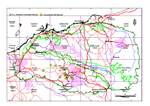Click on images
to enlarge



Photographer: B.R. Maslin

Photographer: B.R. Maslin

Photographer: B.R. Maslin

Photographer: B.R. Maslin

Photographer: B.R. Maslin

Photographer: B.R. Maslin
, BRM 8720, lab photo by Fiona McCallum ADJUSTED_sml.jpg)
Seed from one herbarium voucher. Scale in mm. Photographer: F. McCallum.
Botanical name
Acacia exilis Maslin, Nuytsia 4: 87, figs 7 & 11 (1982)
Common name
Muntalkura Wattle
Aboriginal name
Jonanyong or Jananyung (Kurrama)
Description
Shrubs or small trees (1-) 2-6 m tall, single-stemmed or with up to 6 erect, slightly crooked stems arising from ground level, young plants with a rounded crown that may extend ±to the ground, older plants becoming openly branched and 'v'-shaped with the sparse to mid-dense, soft crown foliage confined to ends of branches. Bark grey, longitudinally fissured and fibrous on main stems, smooth on branches. Branchlets terete, not resin-ribbed, glabrous, light brown or red-brown. Phyllodes long and slender, terete, 14-18 cm long, about 1 mm in diameter, not rigid, ascending to erect, slightly curved to shallowly 's'-shaped, glabrous (except upper surface of pulvinus is hairy), sub-glaucous aging dull green; parallel longitudinal nerves numerous, fine, close together and of uniform prominence; the apex delicately hooked, not spiny; pulvinus about 3 mm long, orange. Inflorescences simple; peduncles 8-13 mm long, glabrous; spikes prolific, 10-20 mm long, golden, the flowers sub- densely arranged. Flowers 5-merous; calyx cupular, sinuate-toothed. Pods linear, flat but slightly raised over seeds, constricted between seeds, 4-9 cm long, 4-5 mm wide, firmly chartaceous, sub-straight to moderately curved (into an open semi-circle), glabrous, greyish brown. Seeds longitudinally arranged in the pods, obloid-ellipsoid to ellipsoid, 4-5 mm long, slightly shiny, mid-brown to dark-brown, often dull yellowish near aril and areole; funicle folded beneath the small, terminal, whitish (pale yellow when dry) aril.
Characteristic features
Branchlets terete, not resin-ribbed. Phyllodes long and slender (14-18 cm x 1 mm), terete, erect, neither rigid nor perfectly straight, finely and uniformly multi-striate. Flowers sub- densely arranged within spikes 10-20 mm long. Pods flat, constricted between seeds, thin-textured.
Distribution and ecology
Confined to the Pilbara region of northwest Western Australia. It occurs in a restricted area of the Hamersley Range mainly in the general vicinity of Tom Price (extending from Hamersley Station southeast to Coppin Pool); also grows near Mt Windell, about 50 km northeast of Coppin Pool. Grows on rocky slopes and along valleys (often associated with watercourses) in low, undulating rocky hills in iron-rich soils derived from Marra Mamba and Brockman Iron Formations, with several Acacia spp. (e.g. A. ancistrocarpa, A. aneura, A. atkinsiana, A. pruinocarpa, A. xiphophylla) and a ground cover of spinifex.
Flowering and fruiting period
Flowers from May to July, occasionally extending to August. Pods with mature seeds have been collected in October and November.
Affinities
Acacia exilis appears to be most closely allied to A. tenuissima. The two species sometimes grow together and are easily confused on account of their long, slender phyllodes, flowers which are arranged in elongated spikes and similar pods. Acacia tenuissima , however, is distinguished by having resin-ribbed branchlet apices, often shorter and more glaucous phyllodes, paler yellow, more densely flowered spikes, narrower pods and yellow arils; moreover, in the Pilbara A. tenuissima is commonly a shrub 1-3 m tall. Acacia exilis has superficial resemblance to terete phyllode forms of A. aneura (Mulga) with which it sometimes grows. Mulga, however, is distinguished by its grey-green phyllodes, absence of reddish resin hairlets on the new shoots, more densely flowered spikes, free sepals (united in A. exilis) and broader pods. The general field facies of young plants of A. exilis is similar to shrubby forms of A. orthocarpa. However, upon close inspection (with a x10 hand lens) the phyllodes of A. orthocarpa are seen to be marked with characteristic 'resin' dots and are seemingly nerveless ('resin' dots absent and fine longitudinal nerves numerous in A. exilis); furthermore, the pods of A. orthocarpa are broad and woody.
Notes
Resprouts from the base following fire.
Phyllodes of this species have been shown to contain relatively high concentrations cyanogenic glycoside, however, it is not known if they also possess an endogenous enzyme necessary for converting the glycoside into toxic hydrogen cyanide (Maslin et al. 1987). To our knowledge A. exilis has never been incriminated in stock losses, but until its toxic potential has been more thoroughly investigated the species should be treated with some caution.
Conservation status
Not considered rare or endangered.
Origin of name
The botanical name is taken from the Latin exilis (thin, slender), and refers to the slender, lax phyllodes. The common name is derived from the Kurrama people who describe the 'Top End' of their land as the country up in the ranges, around Marandoo and Tom Price, extending as far south as Palm Spring (Wangka Maya 2001). This area definition as depicted in Stevens (2001) is almost coincidental with the known distribution of A. exilis with the exception of the Mt Windell population. The Type collection was obtained from a locality between Milli Milli Spring (Thallipirri) and Coppin Pool (Kangkalakarinha) which is within Muntalkura.
References
Maslin, B.R., Conn, E.E. and Dunn, J.E. (1987). Cyanogenic Australian species of Acacia: a preliminary account of their toxicity potential. pp. 107-111. In: J.W. Turnbull (ed.) Australian Acacias in developing countries. Proceedings of an international workshop held at the Forestry Training Centre, Gympie, Australia, 4-7 August 1986. ACIAR Proceedings No. 16. pp. 196. (Australian Centre for International Agricultural Research: Canberra.)
Stevens, P. (2001). The Guruma Story: Told by Guruma Elders Group led by Peter Stevens. Collected and edited by Loreen Brehaut and Anna Vitenbergs. pp. 168. (Jukurrpa Books: Alice Springs, Norther Territory.)
Wangka Maya (2001). Kurrama Wordlist and Sketch Grammar. pp. 193. (Wangka Maya Pilbara Aboriginal Language Centre: South Hedland.)
